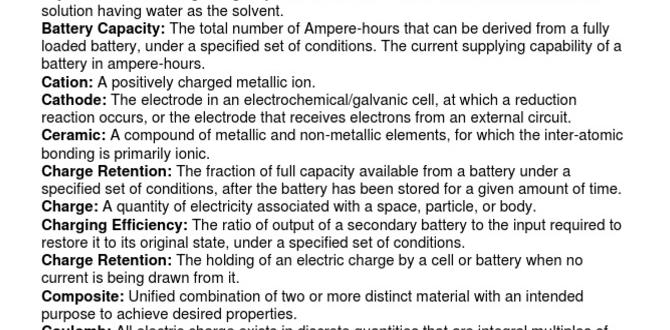Quick Summary: For your Mercedes GLC 300, choosing the right battery means looking for a reliable Group 48 (H6) size, often an AGM type, with a strong warranty. This guide helps you find the best battery for lasting power and peace of mind.
Proven Battery for Mercedes GLC 300: Your Essential Guide
Is your Mercedes GLC 300’s battery acting up? Do you get that sinking feeling when you turn the key, only to hear a weak click? It’s a common problem! Car batteries don’t last forever, and knowing when and how to replace yours is super important. Don’t worry, we’ll break it down in simple terms. You don’t need to be a car expert to understand this. We’ll guide you through finding the right battery, making sure your luxury SUV starts strong every time. Let’s get your GLC 300 powered up!
Understanding Your Mercedes GLC 300’s Battery Needs
Your Mercedes GLC 300 is a sophisticated vehicle, and it relies on a specific type of battery to perform at its best. These cars often come equipped with Absorbed Glass Mat (AGM) batteries. Why AGM? They’re built tough, handle the high electrical demands of modern cars (like all those cool tech features!), and can withstand vibrations better than older battery types. Plus, they do a great job in both hot and cold weather conditions. Getting the right battery isn’t just about power; it’s about compatibility and reliability.
Why Battery Health Matters for Your GLC 300
A healthy battery is the heart of your car’s electrical system. When it’s weak, you might notice:
- Slow engine cranking
- Dashboard warning lights
- Problems with electronics like the radio or power windows
- Complete failure to start
Replacing your battery proactively can save you from being stranded. It’s a preventative step that keeps your GLC 300 running smoothly and ensures all its systems get the consistent power they need.
Choosing the Right Battery: Key Factors
Not all batteries are created equal, especially for a premium vehicle like the Mercedes GLC 300. Here’s what you need to consider:
Battery Size and Type
The most common battery size for the Mercedes GLC 300 is the Group 48, also often referred to as H6. Always double-check your owner’s manual or the car’s battery tray to confirm the exact size. As mentioned, most GLC 300 models use AGM batteries. They are designed to handle the demands of start-stop systems and the car’s advanced electronics, offering better performance and longer life than traditional flooded batteries.
Cold Cranking Amps (CCA)
CCA measures a battery’s ability to start an engine in cold temperatures. For the GLC 300, look for a battery with a CCA rating that meets or exceeds the manufacturer’s recommendation. Typically, something in the range of 650-750 CCA is a good benchmark, but always verify for your specific model year. Higher CCA means better performance when it’s chilly outside.
Reserve Capacity (RC)
Reserve Capacity tells you how long a fully charged battery can deliver 25 amps at 80°F (27°C) before its voltage drops below usable levels. A higher RC is generally better, especially if you often find yourself running accessories with the engine off.
Brand Reputation and Warranty
Stick with reputable battery brands known for quality and reliability. Brands like Bosch, Optima, Odyssey, ACDelco, and Duralast are often good choices. A longer warranty (e.g., 3-5 years) is a strong indicator of the manufacturer’s confidence in their product and provides you with peace of mind.
Top Battery Brands for the Mercedes GLC 300
While availability can vary, here are some highly-regarded battery brands that typically offer suitable options for your Mercedes GLC 300. Always confirm the exact specs before purchasing.
| Brand | Typical Type | Key Features | Warranty Example |
|---|---|---|---|
| Bosch | AGM (Group 48/H6) | Excellent performance, reliable, often OEM spec | 3-4 years |
| Optima Batteries | AGM (SPIRALCELL TECHNOLOGY) | Deep cycle capabilities, vibration resistance, durable | 3 years |
| Odyssey Battery | AGM (Thin Plate Pure Lead) | Extreme durability, long service life, high power density | 3-4 years |
| ACDelco | AGM (Group 48/H6) | Good balance of performance and price, known for reliability | 2-3 years |
| Duralast Platinum (AutoZone) | AGM (Group 48/H6) | Accessible, good warranty, designed for demanding vehicles | 3-5 years |
It’s always wise to check multiple sources and read recent reviews for the most current information on battery performance and warranty terms. The National Highway Traffic Safety Administration (NHTSA) offers general information on vehicle batteries and safety, which can be a useful resource.
How to Replace Your Mercedes GLC 300 Battery: A Beginner’s Guide
Replacing a car battery might seem daunting, but it’s a manageable DIY project if you follow the steps carefully and prioritize safety. If you’re not comfortable, a professional mechanic can always help.
Safety First! What You Need
Before you begin, gather these essential safety items and tools:
- Safety Glasses: Protect your eyes from acid or debris.
- Gloves: Keep your hands clean and protected.
- Wrench Set (Metric): You’ll likely need a 10mm and possibly a 13mm or 15mm wrench for terminals and hold-down clamps.
- Battery Terminal Cleaner: A wire brush or specialized tool to clean corrosion.
- New Battery: Ensure it’s the correct Group 48 (H6) AGM as confirmed.
- Rag or Paper Towels: For cleaning.
- Anti-Corrosion Spray or Grease: To protect terminals.
- Optional: Memory Saver: A device that plugs into your OBD-II port to maintain vehicle settings (radio presets, etc.) while the battery is disconnected.
Step-by-Step Replacement Process
Here’s a straightforward way to change your GLC 300’s battery:
- Park Safely: Park on a level surface, turn off the engine, and engage the parking brake.
- Open the Hood and Locate the Battery: The battery in the GLC 300 is typically located in the trunk, often under the floor panel. Consult your owner’s manual if you’re unsure.
- Access the Battery: Remove any floor coverings or panels to get to the battery. You might need to lift a section of the trunk liner.
- Disconnect the NEGATIVE (-) Terminal FIRST: Using your wrench, loosen the nut on the clamp connected to the negative (black) terminal. Gently twist and pull the cable off the terminal. Tuck it away so it doesn’t accidentally touch the battery post. This is crucial for safety to prevent sparks.
- Disconnect the POSITIVE (+) Terminal SECOND: Now, loosen and remove the clamp from the positive (red) terminal. Tuck this cable away as well.
- Remove the Battery Hold-Down Clamp: Most batteries have a bracket or clamp securing them to the tray. Locate and remove the bolts or nuts holding this clamp in place. Keep these fasteners safe!
- Lift Out the Old Battery: Batteries are heavy! Carefully lift the old battery straight up and out of the tray. If it’s too heavy, get help. Avoid tipping it.
- Clean the Battery Tray and Terminals: Use your rag and cleaner to remove any dirt, corrosion, or debris from the battery tray and the cable connectors.
- Install the New Battery: Carefully place the new battery into the tray, ensuring it’s oriented correctly (usually with the positive and negative posts in the same position as the old one).
- Secure the Battery: Reinstall the hold-down clamp and tighten its bolts or nuts to secure the battery firmly. It shouldn’t move at all.
- Connect the POSITIVE (+) Terminal FIRST: Place the positive cable clamp onto the positive terminal post of the new battery. Tighten the nut securely.
- Connect the NEGATIVE (-) Terminal SECOND: Attach the negative cable clamp to the negative terminal post. Tighten the nut firmly.
- Apply Anti-Corrosion Protection: Lightly spray or brush some anti-corrosion grease or spray onto the terminals. This helps prevent future corrosion.
- Replace Covers: Put back any trunk panels or floor coverings you removed.
- Test the System: Close the trunk, start your car, and check that everything powers up normally. Test the lights, radio, and other electronics.
If you used a memory saver, unplug it after the car has started and run for a few minutes.
Battery Maintenance Tips for Longevity
Even with the best battery, a little care goes a long way to ensure it lasts as long as possible.
Regular Cleaning
Keep the battery terminals clean and free of corrosion. You can do this during routine checks. A little white powdery substance is corrosion, and it can be cleaned off with a stiff brush and a mixture of baking soda and water. Always disconnect the battery before cleaning.
Secure Connections
Ensure the battery cables are always Tightly connected. Loose connections can cause starting problems and damage the battery and electrical system.
Avoid Deep Discharges
Try not to leave lights, accessories (like the radio or a phone charger), or the car’s ignition on for extended periods without the engine running. This can drain the battery excessively and shorten its lifespan.
Check for Leaks or Damage
Periodically inspect the battery for any signs of physical damage, swelling, or leaks. If you see any, the battery should be replaced immediately.
Professional Checks
Many auto shops offer battery testing services, often for free. If you’re unsure about your battery’s health, a quick test can give you valuable insight.
When to Consider Professional Help
While battery replacement is a common DIY task, there are times when it’s best to call in the pros:
- Uncertainty: If you’re not confident in your ability to perform the steps safely and correctly.
- Difficult Access: If the battery is located in a hard-to-reach spot or requires special tools to access.
- Electrical System Concerns: If you suspect a deeper electrical issue beyond just a dead battery.
- Proper Disposal: Professionals can ensure the old battery is recycled properly, which is important for environmental reasons.
Most auto service centers, including dealerships and independent mechanics, can handle battery replacements efficiently. When in doubt, a professional diagnosis is always a good bet.
| Common Battery Problem | Possible Cause | Simple Solution/Check |
|---|---|---|
| Car won’t start, just clicks | Weak or dead battery | Check battery terminals for corrosion, test battery health |
| Slow engine crank, especially in cold | Battery losing its power | Consider replacing if battery is old (over 3-5 years) |
| Dashboard warning lights illuminate | Low battery voltage or charging system issue | Check battery voltage, have charging system tested |
| Electronics acting erratically (lights dim, radio cuts out) | Insufficient battery power | Inspect battery terminals and connections |
| Battery case is swollen or leaking | Overcharging or internal damage | Replace battery immediately, have charging system checked |
Frequently Asked Questions (FAQ) About Mercedes GLC 300 Batteries
Q1: How often should I replace my Mercedes GLC 300 battery?
Most car batteries, including those in a Mercedes GLC 300, typically last between 3 to 5 years. However, factors like climate, driving habits, and the quality of the battery can affect its lifespan. It’s a good idea to have your battery tested annually after the third year.
Q2: Can I use a regular flooded battery instead of an AGM battery in my GLC 300?
While it might seem like a cost-saving measure, it’s generally not recommended to switch from an AGM battery to a standard flooded battery in a Mercedes GLC 300. AGM batteries are designed for the specific electrical demands and charging systems of modern luxury vehicles, including those with start-stop technology. Using the wrong type could lead to performance issues or premature battery failure.
Q3: Where is the battery located in a Mercedes GLC 300?
In most Mercedes GLC 300 models, the battery is located in the trunk, beneath the floor panel. You’ll typically need to lift up a section of the trunk’s carpet or mat to access it.
Q4: How much does a battery replacement for a Mercedes GLC 300 typically cost?
The cost can vary based on the brand of battery and where you have it installed. For a quality AGM battery suitable for a GLC 300, you might expect to pay anywhere from $200 to $400 for the battery itself. Professional installation might add another $50 to $150, depending on the shop’s labor rates.
Q5: What does “AGM” mean for my car battery?
AGM stands for Absorbed Glass Mat. This type of battery uses fiberglass mats to absorb the electrolyte liquid. AGM batteries are known for being more durable, vibration-resistant, leak-proof, and able to handle higher electrical loads compared to traditional flooded lead-acid batteries, making them ideal for modern vehicles with many electronic features.
Q6: My car battery died. What are the common reasons besides age?
Common reasons for a battery dying prematurely include leaving lights or accessories on, a faulty alternator that isn’t recharging the battery properly, parasitic draw (where a component drains the battery even when the car is off), extreme temperatures, and frequent short trips that don’t allow the alternator enough time to fully recharge the battery.
Conclusion
Taking care of your Mercedes GLC 300’s battery is a vital part of keeping your vehicle running reliably. By understanding the importance of the right battery type (typically an AGM Group 48/H6), paying attention to key specifications like CCA, and opting for reputable brands with good warranties, you’re setting yourself up for success. Whether you choose to tackle the replacement yourself with our step-by-step guide or opt for professional service, remember that safety and proper procedures are paramount. Regular maintenance, even simple cleaning and connection checks, can extend the life of your new battery. Now you have the knowledge to make an informed decision and keep your GLC 300 powered up and ready for any journey!



